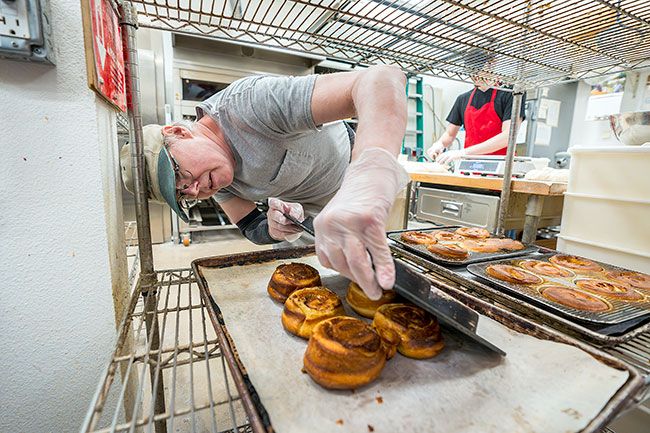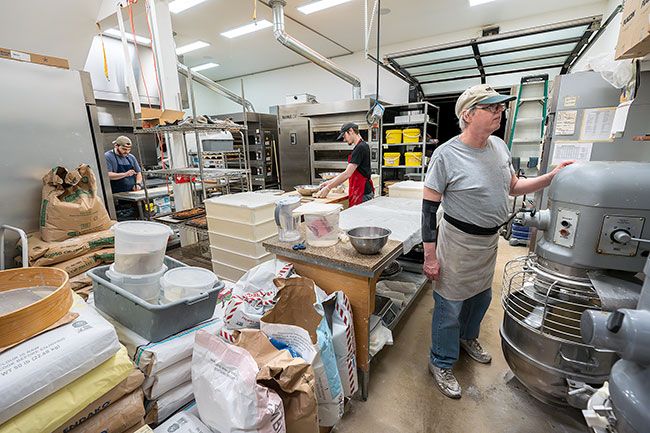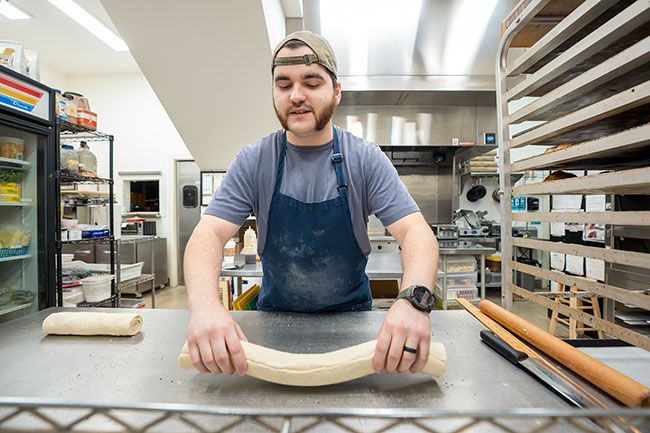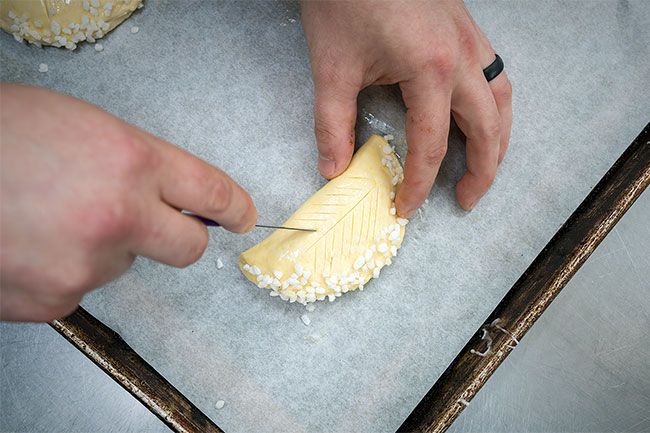'24 Hours: 5 to 6 a.m. at the bakery




It’s a foggy late September morning that will turn out to be a damp, cool Thursday. Such a day is just right for having coffee and a pastry in front of the fireplace in the bakery’s dining room, general manager Iain Danicic said.
For now, though, the slight chill is welcome: the three bakers crack open an exterior door to make it more comfortable in the kitchen filled with ovens, proofers, bright lights and hard work.
General manager Iain Danicic, a Newberg resident who worked his way up from customer service to baking, has been on the job for about an hour already. “I like early hours,” he said. “I don’t like waiting to go to work.”
Production manager David Boone of McMinnville started making dough before 3 a.m. He’s worked at the bakery for six years, and he said he’s happy with the overnight shifts. “It keeps me busy,” he said.
The third baker, Gavin Nelson of Carlton, arrives at 5 and immediately begins portioning croissant dough that’s been slowly rising overnight.
Nelson and his coworkers periodically consult a chart that shows what needs to be made this morning, and what time different processes need to be started. Precise timing is important, he said, so breads and pastries will be ready when the bakery opens its front door to customers at 8:30 a.m.
As the 5 o’clock hour ticks by, the bakers shape baguettes and short-loaf batards, chaussons aux pommes (tiny apple pies) and Marionberry tarts, let them proof (another rise), then slide them into the triple-deck ovens. The temperature of each deck can be adjusted separately, as can the temperature of the floor and ceiling of each deck for maximum control.
The aroma increases. Crust, cardamom, almonds, apples, butter, brown sugar … fragrant enough to drive a dieter delirious, but to delight them, too.
The baking area, which most customers don’t see, is a large room with by pathways defined by stacks of sacks – pastry flour, high-protein bread flour, powdered sugar.
Rectangles of two kinds of butter are stacked up, as well, along with tubs of ingredients such as homemade raspberry jam, almond paste, apple compote or a gorgonzola mixture that will be stuffed by spoonfuls into small circles of croissant dough to make gougere, rich bites of flavor.
Everything is neat and easily accessible to the bakers, who would know the territory with their eyes closed. They keep their eyes open, though, ever attentive to the precise amounts of each ingredient needed for consistent results.
They don’t use measuring cups, Nelson said. Those are inexact, since the way flour is packed into the cup might vary.
Rather, aiming for exact amounts, they weigh every ingredient in grams, and divide dough by kilograms. That’s one of Nelson’s jobs — weighing out about 1.65 kg of croissant dough for each batch of seven rolls.
The croissant dough — which earlier went through the process of laminating, adding butter between layers of dough to make it flaky when baked — gets a rest. Then Danicic picks up a batch, flattens it into a rectangle about 9-by-13 inches, and feeds it into the baker’s prized rolling machine.
The machine, which bakers call “our lovely laminator,” works like a human equipped with a pair of rolling pins and very strong muscles. It can flatten dough to any thickness that Danicic selects, as well as do the repeated laminating, pressing together layers of dough and butter, adding more butter each time.
This time, the laminator produces the final dough stage for the croissants. Danicic twirls it onto a cylinder, walks to a table, and unrolls it. Then he measures and cuts strips, then triangles.
Starting at the wide end of each triangle, he rolls the dough into croissant shapes, which then are brushed with melted butter and left to rise before going into the oven.
“Our biggest seller, by far,” he said. “A plain croissant is hard to beat. I could eat 10 a day, if I let myself.”
Danicic handrolls and bakes about three dozen each weekday and four dozen on each day of the weekend. At peak times of the year, he may make five dozen a day.
He says the same laminated dough goes into a variety other pastries, including breakfast croissants stuffed with ham or bacon that he starts making at 5:10 a.m.
“We use this dough so many ways,” he said. “It’s a point of pride to use each of our doughs in several ways … savory, sweet, all delicious.”
Nelson consults the schedule for the morning. It’s 5:30. “Time to do the French dough,” he says.
He hefts a large blob of rising dough that Boone mixed up in the huge Hobart at 2:45 a.m.; the commercial mixer is still running at 5:15 a.m., this time “whacking around” eggs and butter for brioche, Boone says.
Breaking off sections, Nelson weighs each piece of the French dough, removing a little or adding some to make them uniform weight — one size for skinny baguettes, a larger size for wider batard loaves. He rolls each piece into a ball, then places it into a container for an additional rise.
After final shaping, proofing and baking, he said, “they’ll be ready at 8:30 or 9.”
Everything has to be fresh for today’s customers, Nelson and Danicic say. They would rather sell out — and breads and pastries often do, so they advise customers to arrive early — than have leftovers.
“We’re vastly about quality over quantity,” says Danicic, who will mark his sixth anniversary with Carlton Bakery on Oct. 18.
An alarm sounds, interrupting the conversation, but not the work. Bakers respond by moving to the oven, turning a pan of pastries on one deck, and pulling long loaves of buttery, eggy brioche from another.
Nelson sets the brioche to cool. The soft, rich dough makes its a tricky bread to make, he says. This morning, the dough cooperated and the loaves looks perfect.
The bakery uses the brioche dough in some pastries as well as baking it in loaf pans to sell outright or to slice for French toast breakfasts. Nelson said he’s tried making French toast with the brioche at home; now he will never use anything else.
As a teenager, he applied for work at Carlton Bakery. Owner Tim Corrigan, a McMinnville native who opened the bakery in 2012 after learning the art of French baking while living in Japan, told him he didn’t have a position for him then.
Nelson did a stint in the Marines before applying again. This time, he was hired for what he calls “the best job I ever had” because he likes the atmosphere, his coworkers and the physical nature of pushing dough around.
Nelson checks the brioche again; satisfied, he returns to his stainless steel table. He measures out pastry flour, which has almost no gluten, compared to bread flour. Then he cuts in butter and adds ingredients to make two batches of lemon blueberry scones.
As an oven timer rings at 5:52 a.m., signaling the end of another baking time, Nelson says he’s proud that his scones are another popular seller. “It’s hard to keep up with sales of those,” he said.
All three bakers are proud of what they do. They all know their jobs well, Danicic said, and they are pleased to make things that people enjoy.
“It’s a big sense of pride to have, at 8 a.m., a beautiful rack of fresh pastry,” Danicic said. “It’s great to know someone’s day is a little better because of what we’ve made.”
Reporter and photographer leave the bakery at 6 a.m. Three hours later, the reporter returns, entering the retail shop this time to see the display cases laden with shimmering pastries, flaky croissants and humble-looking, but aromatic, fresh loaves.
Hard choices must be made. An almond croissant, pain au chocolat, Marionberry tart and a sea biscuit are nestled in a box, left open because some of the pastries are still a little warm. A debit card slides.
Now comes the second question of the morning: What is the longest-lasting, most difficult drive in Yamhill County?
The answer: the route between Carlton Bakery and the News-Register newsroom. Six excruciating miles of not reaching into that box.








Comments
Buford the 1st
Oh my gosh....my stomach is growling so much right now. I can almost smell the aroma of the bakery. Very nicely written piece. Thank you???? 😉